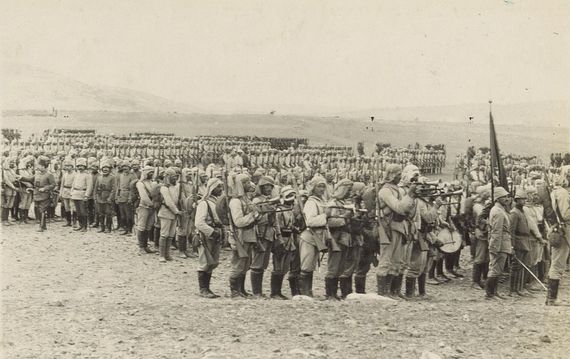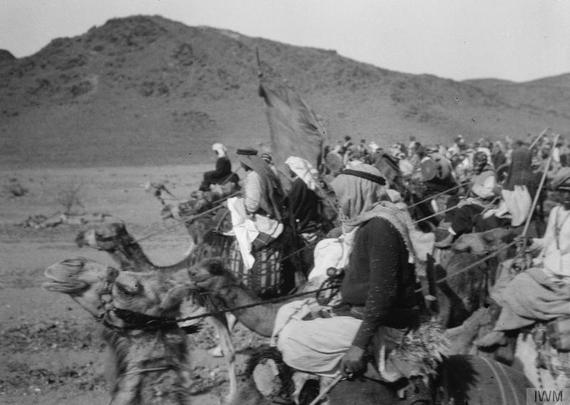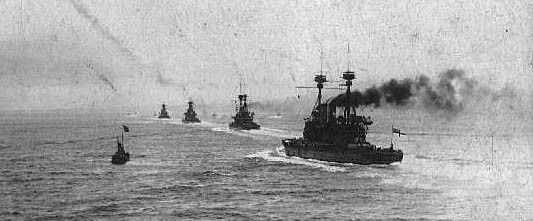The Middle East Theater in World War I: Winter 1915
Turkish Infantry Prepares to Attack the Suez Canal
At the beginning of 1915, two new areas of conflict emerged in the Middle East Theater. In Egypt, a Turkish-German force crossed the Sinai Peninsula and attempted to seize control of the Suez Canal. The attack would result in the buildup of British forces in Egypt and led to the decision to begin arming Bedouin tribes in the Arabian Peninsula that were revolting against the Ottoman Empire. In addition, the continued stalemate on the western front and Russian requests for Anglo-French assistance to relieve pressure on its troops in the eastern front and the Caucasus had led Winston Churchill, First Lord of the Admiralty, to propose a plan to seize control of the Dardanelles and attack Constantinople, forcing the Ottoman Empire out of the war. These two decisions would play a pivotal role in the postwar organization of the Middle East and leave a legacy that reverberates to this day.
The Campaign in Sinai and Palestine
It was Britain, supported by Empire troops, which took on the Ottoman and German Empires in the Sinai and Palestine campaigns. These campaigns lasted from January 1915 until shortly before the end of the War. Originally part of the Ottoman Empire, Egypt had been occupied by the British since the 1880s. Through Egypt ran the Suez Canal, which was Great Britain's vital lifeline between her Asian Empire and the home country. British Empire forces defended Egypt, and the Royal Navy protected the canal itself.
Arab Rebellion in the Arabian Desert 1915
In January 1915, attacking out of a sandstorm, a German-Ottoman force of 25,000 Turkish troops invaded Egypt's Sinai Peninsula and attacked the strategically important Suez Canal. They were fought off by entrenched infantry, supported by the heavy guns of the Royal Navy's warships, and had withdrawn eastward. This would be the first of what would be repeated Ottoman attempts to take control of the Sinai. The objective was to seize control of the Suez Canal and deny its use to Great Britain and the Allies while at the same time forcing Great Britain to commit large numbers of troops to the Middle East. Troops deployed in the Middle East would not be available for duty on the Western Front.
Gallipoli
The campaign in Gallipoli was one of the most infamous operations of World War I. Although the campaign is well known, its genesis and evolution is far less familiar. It resulted in an Ottoman victory, perhaps their most significant of the war. Combined with Ottoman successes in the Mesopotamian campaign during 1915, it underscored the fact that the Ottoman Empire could conduct an effective protracted defense and that, notwithstanding its lack of modern weapons and training, the Ottoman Army still remained a formidable force.
Anglo-French Fleet in the Dardanelles, February 1915
After Gallipoli, the notion that Turkey could be quickly knocked out of the war was abandoned. The failure was an embarrassing defeat for the Allies. It cut short, temporarily, the career of Winston Churchill, First Lord of the Admiralty, the man who was most closely associated with the plan, while at the same time launched the meteoritic rise of an obscure Turkish commander named Mustafa Kemal.
Early in 1915, in response to the ongoing stalemate on the Western Front,
Churchill had proposed a military operation to seize the Turkish Straits, the complex of waterways, consisting of the Dardanelles, the Sea of Marmara and the Bosporus, which connected the Mediterranean Sea, via the Aegean, with the Black Sea. The original plan called for combined land and naval forces to launch an attack in order to secure the Ottoman forts guarding the straits and force the passage to Constantinople. Safely anchored in the Golden Horn, Constantinople's historic anchorage, the big guns of the Royal Navy would intimidate the Ottoman government into submission.
Control of the straits would open up a southern route to ship supplies to the Russian forces on the Eastern Front. In addition, the Black Sea was Russia's principal export outlet for its annual wheat crop. With the Baltic and the Black Sea now closed off to Russian shipping, the only other available ports were the Arctic ports of Murmansk and Archangel and the Pacific port of Vladivostok at the other end of the 3,000-mile Trans-Siberian railroad. The Arctic ports were not well developed and could not handle any significant amount of shipping. Neither could the single track rail line from Vladivostok.
Success at Gallipoli, it was believed, would also result in the defeat of the Ottoman Empire and knock them out of the war. If Germany came to the aid of the Ottomans it would have to reduce its forces on either the Eastern or Western Fronts. If it didn't, and Constantinople was forced to make a separate peace, then the way was open for Allied forces to land in the Eastern Mediterranean and wage war along an enlarged Eastern Front. Sir John Fisher, First Sea Lord, tentatively supported Churchill. Together, they convinced the Minister of War, Lord Kitchener, who reluctantly agreed to the plan, but only if it was limited to just the Royal Navy and did not require the commitment of ground forces. What would become the first phase of the protracted Gallipoli campaign was scheduled for February 1915. It would prove to be the first of a long series of Allied disasters.



